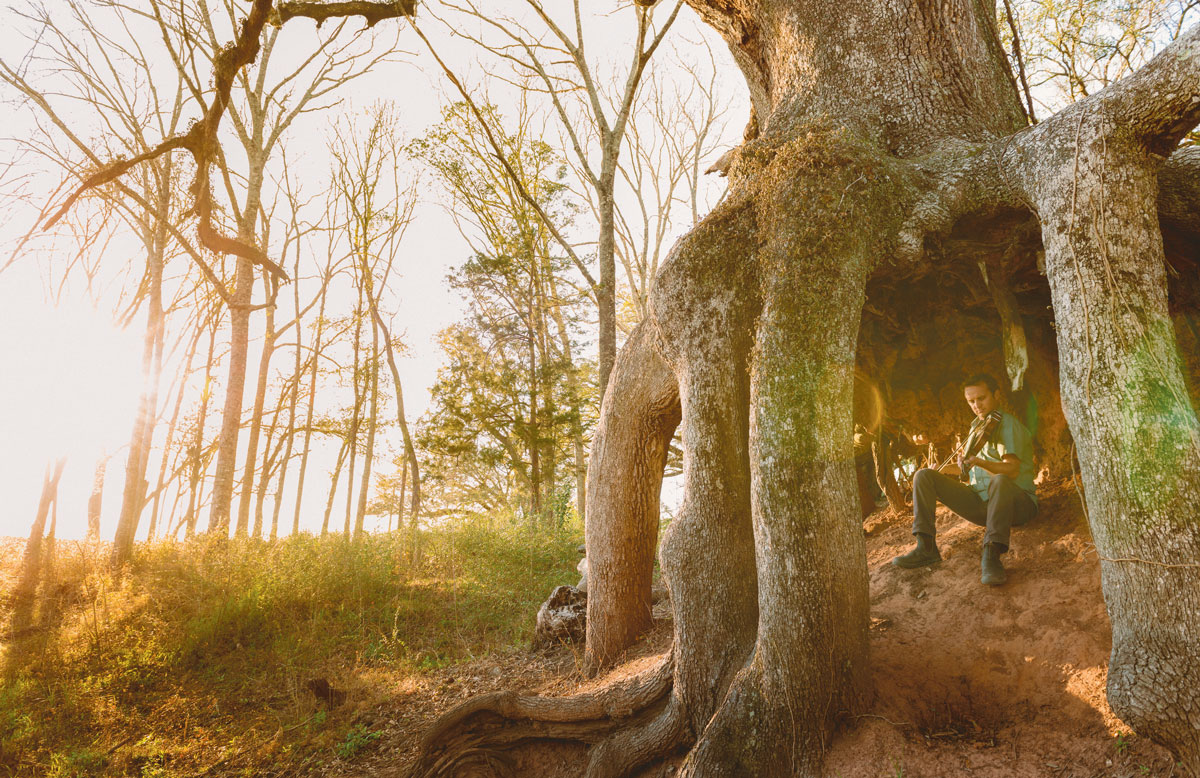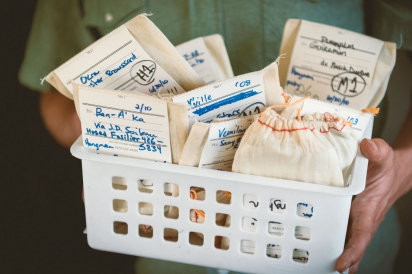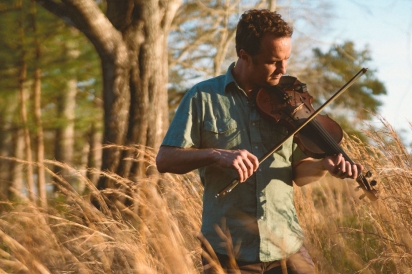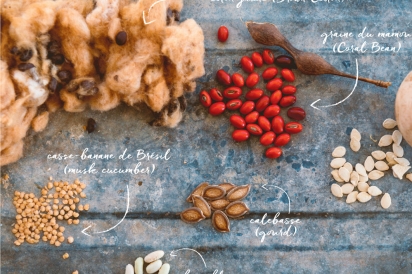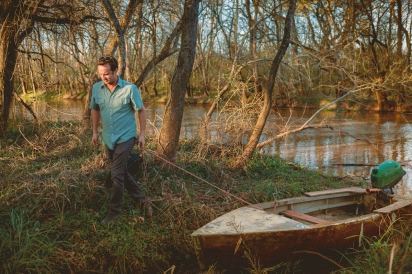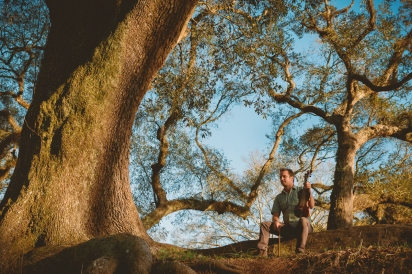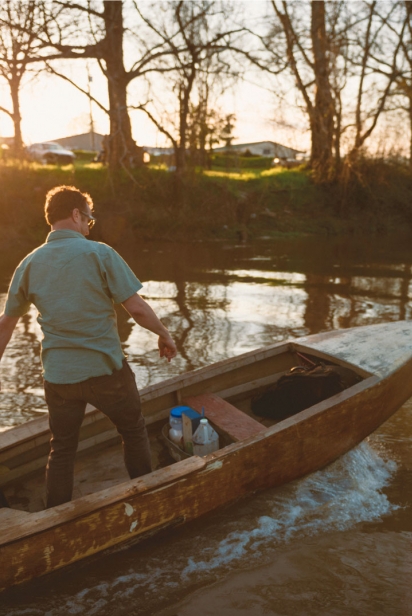Striking a Chord
Louis Michot of Lost Bayou Ramblers finds harmony between music & food
Years ago, before I even thought of New Orleans as a possible home city, I lived in Park Slope, a neighborhood in Brooklyn, New York, where the streets were dotted with trees and historic brownstones. Walking up the block from my apartment towards 7th Avenue, the main shopping drag, I would often hear the raucous sounds of a fiddler ripping on his instrument, the notes coming fast and furious and bouncing downhill to me.
I would always find him in the same spot: in front of a small family-owned organic grocery store that was nestled among other small family-owned stores, across the street from a video store and a bookstore (when those things still existed). On the ground in front of him sat his open fiddle case, a smattering of change and a few bills inside it. Sometimes there was a crowd gathered in front of him; other times, no one at all.
Nonetheless, he would dance around, two-stepping wildly while his rosin-covered fingers skillfully transitioned from one piece of music to the next, from the exuberant to the plaintive, singing in a unique keening timbre and belting out songs, the words to which I didn’t understand, but whose emotions I felt all the same.
And then one day, he was gone.
I probably assumed that he was a transient who’d decided that Park Slope, with its proliferation of trendy restaurants and bars, new Starbucks, and fresh hipster identity, wasn’t quite the place for him. It wasn’t until I moved to New Orleans and attended a concert featuring the Grammy-nominated Cajun rock band Lost Bayou Ramblers that I realized that the fiddler who for weeks, and perhaps months, had played on the street corner just blocks from my apartment had been none other than the band’s lead singer and fiddler extraordinaire, Louis Michot.
Louis now lives in a home surrounded by a thousand trees on eight acres, a place he shares his wife of 10 years, their two sons, one rooster, four laying hens and two resident goats, Billy and Eskar.
The first Michot arrived in Louisiana from Haiti, by way of Cuba, in the early 1800s. Of Caribbean ancestry, but deeply rooted in the bayou, Louis was born in Baton Rouge, Louisiana, and raised in Lafayette among a family of musicians and farmers. Immediate or extended, they can all play a note or two in a pinch. In his teens, Louis performed as a member of Les Frères Michot, and played alongside his father and uncles. Music came naturally, and was an extension of the time that he spent with his family. But though it seemed as if music was to become his profession, what he really wanted was to be a farmer.
The Michots lived very closely with the land—farming, hunting and fishing. Louis kept a garden at his grandparents’ house through high school, and would tend it assiduously until he had to leave for the summer to go play music. He’d return weeks later to find that the horses had broken in and devoured his harvest. “I couldn’t keep those horses away!” he exclaimed. “I had to keep improving my fences!”
For Louis, food and music and family are all part of the same song. “All the family would come over [to my grandparents’ house on Sundays], and we’d have tons of rice and gravy and a roast of some sort or gumbo or catfish court-bouillon, or smothered okra, and on and on and just so much food.” His voice softens as he becomes nostalgic. “I just loved sitting at the table at my grandparents’ house. There was always some good food to be eaten on any given day—some fish that my grandpa caught or possibly some game from one of my uncles or some produce that a neighbor brought over, satsumas, snap peas or whatever.”
In his youth, he often spent evenings out dancing with his many cousins. They would go to Les Frères Michot gigs, at festivals and clubs, and jitterbug and two-step the night away as his father and uncles played on stage—a family of Michots dancing to music created by Michots. The perfect combination of joyfulness coupled with youth, something you don’t really appreciate until it’s behind you.
Louis initially attended college as a music major, but left after a semester due to his preference for playing by ear and improvising, which didn’t mesh with the curriculum. “In essence, I quit music school in order to play music,” he recalled, “and then I went back a year later for sustainable agriculture because I had already started studying that on my own. And then I quit that to go work on a permaculture project taking place at the North Louisiana at the Army Ammunition Plant, where these permaculture experts were researching sustainable system design.”
“To me the two most precious things in life are food and music. My father was a musician by night and a wetlands biologist by day, so ecological awareness and music have always been a part of my life and have walked hand in hand,” he explains. “I really wanted to sustainably grow food, and I wanted to learn how to use local seeds and local sustainable methods to do it.”
To that end, Louis packed up his fiddle and made his way to New York City, to the Bronx Botanical Garden, and began to take classes there in his effort to increase his knowledge of sustainable agricultural practices. Music then became a means to an end; a means to earn enough money to support himself by playing on the streets of New York City, and Brooklyn.
Ironically, it was during his time at the Botanical Garden that Louis dove deeper into music. He found himself skipping school in order to go play.
“Music was so dear and precious to me that I didn’t want to play for money, but at the same time it was the only tool that I had to earn money,” he says. “And the more I played on the street, the more I learned.”
He found himself on the streets every day, and evolved not only as a musician but also as a performer. Playing on the streets meant that he had to compete for people’s attention, and connect with them in a way that would compel them to stop to listen as they approached him. He learned how to make a lasting impression during the briefest moments that he was allotted, and ultimately discovered how to connect with an audience through music.
This was 2002, and by this time Lost Bayou Ramblers, the band that he fronts with his brother Andre, had already been in existence for three years. Louis’ success playing to a responsive New York City audience compelled him to book the band’s first tour, and from that point there was no turning back.
“It was at that time that music really showed itself as what I loved to do and what I do naturally, so it kind of switched and I found myself thinking, ‘Well, I’ll just grow food for pleasure.’“
Louis admits that he had always been more of a traveler than a farmer, two lifestyles that don’t live harmoniously together. Though farming was relegated to hobby, his interest in agriculture didn’t subside. One day, he met a man named Lester Broussard, who was selling seedlings that he had grown. Louis bought a few to plant in his own garden, but also asked Mr. Broussard where the seeds came from. He replied that he’d had them for as long as he could remember, and had been planting them for just as long.
“When I met Mr. Broussard, I thought about how old he was and about him growing his plants and preserving the seeds, and I saw the need to gather the knowledge that he had and to make sure that it was remembered and used, because so often the knowledge and the seeds of this older generation, who are from a time when this was a necessity, are not passed on because their kids and grandkids don’t need it and don’t bother to learn it, so it’s lost forever.”
So, in 2007, he founded the Cultural Research Institute of Acadiana (CRIA), a nonprofit whose mission is to gather local heirloom varieties of edible, medicinal and useful seeds, and preserve them and the knowledge that is necessary for planting and harvesting. Simply put, to grow local produce from entirely local seeds, while following as much of the old ways as possible.
Through myriad interviews with traditional South Louisiana growers, CRIA is ensuring that the information gathered is recorded and preserved for future use. For example, Mr. Broussard’s use of mule technology without the mule: Instead, he uses an old plow, pulled by a four-wheeler. Or the enterprising use that he developed for old muskrat iron metal springs whose original application was to stretch and dry out muskrat furs, but are now utilized to implant vinegar bottles into the ground in order to create individual greenhouses around his plants.
With this effort, CRIA has been able to collect crucial knowledge, as well as some rare seeds that might otherwise have been lost forever. It’s a labor of love from a man who glimpsed the future and realized that there was a benefit to reaching out to an older generation in order to learn and preserve their indigenous methods, and ultimately apply them to modern practices to create a more sustainable system.
“My pattern is to plant, then go travel, and then come back and deal with it. But you can’t be a rambler and a farmer. I’ve chosen music and music has chosen me and I’ve accepted that, but I feel like in this way I’m still very much honoring my love of the land.”


